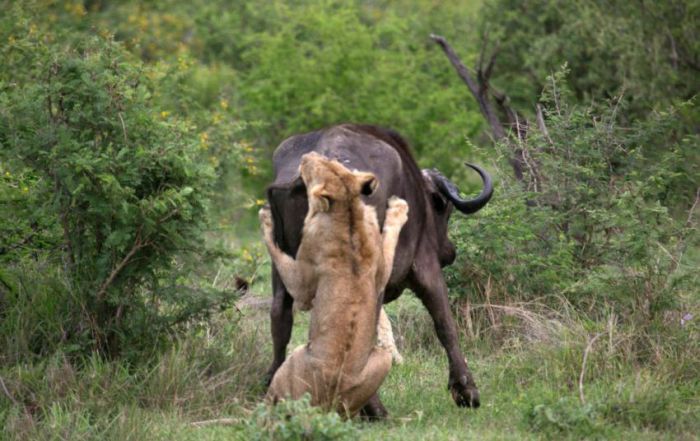|
|
Lioness Against A Buffalo With Friends
|
Social behavior
Herd size is highly variable. The core of the herds is made up of related females, and their offspring, in an almost linear dominance hierarchy. The basic herds are surrounded by subherds of subordinate males, high-ranking males and females and old or invalid animals. The young males keep their distance from the dominant bull, who is recognizable by the thickness of his horns. During the dry season, males will split from the herd and form bachelor groups. Two types of bachelor herds occur: ones made of males aged four to seven years and those of males 12 years or older. During the wet season, the younger bulls rejoin a herd to mate with the females. They stay with them throughout the season to protect the calves. Some older bulls cease to rejoin the herd, as they can no longer compete with the younger, more aggressive males. Males have a linear dominance hierarchy based on age and size. Since a buffalo is safer when a herd is larger, dominant bulls may rely on subordinate bulls and sometimes tolerate their copulation.
Adult bulls will spar in play, dominance interactions or actual fights. A bull will approach another, lowing, with his horns down and wait for the other bull to do the same thing. When sparring, the bulls twist their horns from side to side. If the sparring is for play, the bull may rub its opponent’s face and body during the sparring session. Actual fights are violent but rare and brief. Calves may also spar in play, but adult females rarely spar at all.
African buffaloes are notable for their apparent altruism. Females appear to exhibit some sort of “voting behavior”. During resting time, the females will stand up, shuffle around, and sit back down again. They will sit in the direction they think they should move. After an hour of more shuffling, the females will travel in the direction they decide. This decision is communal and not based on hierarchy or dominance. When chased by predators, a herd will stick close together and make it hard for the predators to pick off one member. Calves are gathered in the middle. A buffalo herd will respond to the distress call of a captured member and try to rescue it. A calf’s distress call will get the attention of not only the mother, but also the herd. Buffaloes will engage in mobbing behavior when fighting off predators. They have been recorded killing a lion and chasing lions up a tree and keeping them there for two hours, after the lions have killed a member of their group. Lion cubs can get trampled and killed. In one videotaped instance, known as the Battle at Kruger, a calf survived an attack by both lions and a crocodile after intervention of the herd.
|
|









